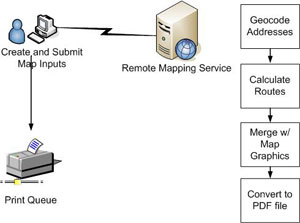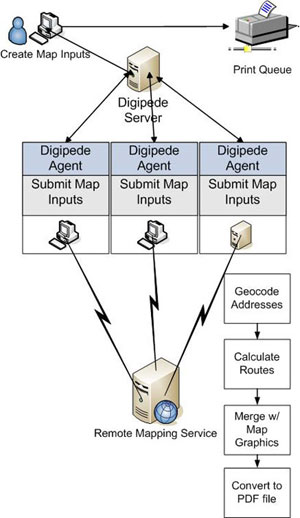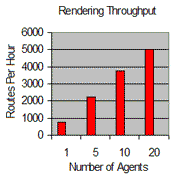Trekk Cross-Media Boosts Throughput with Digipede
The Fastest Route to Rendering Performance
The Company
"We saved a bundle on new hardware, and simplified our software design. But
the biggest benefit was business continuity."
- Jeff Stewart, VP of Technical Services at Trekk Cross-Media
Trekk Cross-Media is a full-service marketing, communication, and promotional agency that provides a unique
blend of strategic business thinking, marketing creativity, and best-of-breed technologies.
When Trekk Cross-Media took on the contract to provide direct mail services for one of the nation's largest retailers, it brought its usual flair for creativity and innovation to the job. Along with special offers the retailer provided, why not provide a map and directions to the nearest store, customized for each individual address? With new stores opening and a high turnover of homeowners and renters, these custom directions proved a hit in test markets of a few thousand people.
The Challenge
 With this success came requirements for increased scale. The retailer asked Trekk to roll out its custom map
program to hundreds of thousands of recipients. Trekk's ability to render maps and directions became an
important limiting factor on its business. Buying more hardware and converting its applications to a
multi-threaded model proved difficult and expensive, and did not provide sufficient performance benefits
(see Figure 1). In order to meet the job's demands, the company needed to increase its throughput immediately
by an order of magnitude or more.
With this success came requirements for increased scale. The retailer asked Trekk to roll out its custom map
program to hundreds of thousands of recipients. Trekk's ability to render maps and directions became an
important limiting factor on its business. Buying more hardware and converting its applications to a
multi-threaded model proved difficult and expensive, and did not provide sufficient performance benefits
(see Figure 1). In order to meet the job's demands, the company needed to increase its throughput immediately
by an order of magnitude or more.
The Solution
Jeff Stewart, Vice President of Technical Services at Trekk, attended one of Digipede's Webcasts. In thirty minutes, he learned how the Digipede Framework SDK could help him grid-enable his application with just a few lines of code. He downloaded a trial version of the Digipede Network, tested it on his application, and liked what he saw. He purchased the Digipede Network Team Edition from the Digipede Web store, and was creating customized maps with a 20-node system in a few days.
 "We were afraid we'd have to purchase a large scale multiprocessor system," said Stewart. "The Digipede Network
made it simple to get the performance we need from the installed Windows network we already have. We saved a
bundle on new hardware, and simplified our software design. But the biggest benefit was business continuity.
We're changing from a multi-threaded application to a linear one that can scale out with Digipede." (See Figure 2.)
"We were afraid we'd have to purchase a large scale multiprocessor system," said Stewart. "The Digipede Network
made it simple to get the performance we need from the installed Windows network we already have. We saved a
bundle on new hardware, and simplified our software design. But the biggest benefit was business continuity.
We're changing from a multi-threaded application to a linear one that can scale out with Digipede." (See Figure 2.)
As a proof-of-concept, Stewart's team used the Digipede Workbench with its point-and-click user interface to distribute a simple, command-line form of their application. After examining the Digipede SDK, they quickly realized that taking advantage of Digipede's integrated .NET and COM capabilities would be straightforward and would help them achieve dramatically improved performance.
The Digipede Network allowed Trekk to spread the computing load of its route and map creation application across
a network of 20 machines instead of just one. With more machines allocated to the project, throughput increased
 from 750 customized routes per hour to over 5,000 per hour—enabling Trekk to complete the critical project for
its large national retail client in short order. (See Figure 3.)
from 750 customized routes per hour to over 5,000 per hour—enabling Trekk to complete the critical project for
its large national retail client in short order. (See Figure 3.)
"Digipede helped us deliver for a major customer, and lets compete for larger projects going forward," said Stewart. "The Digipede Network just took scalability off the table as an issue. Our infrastructure will now support projects of any scale; we can just add new hardware and Digipede Agents as our business grows."


